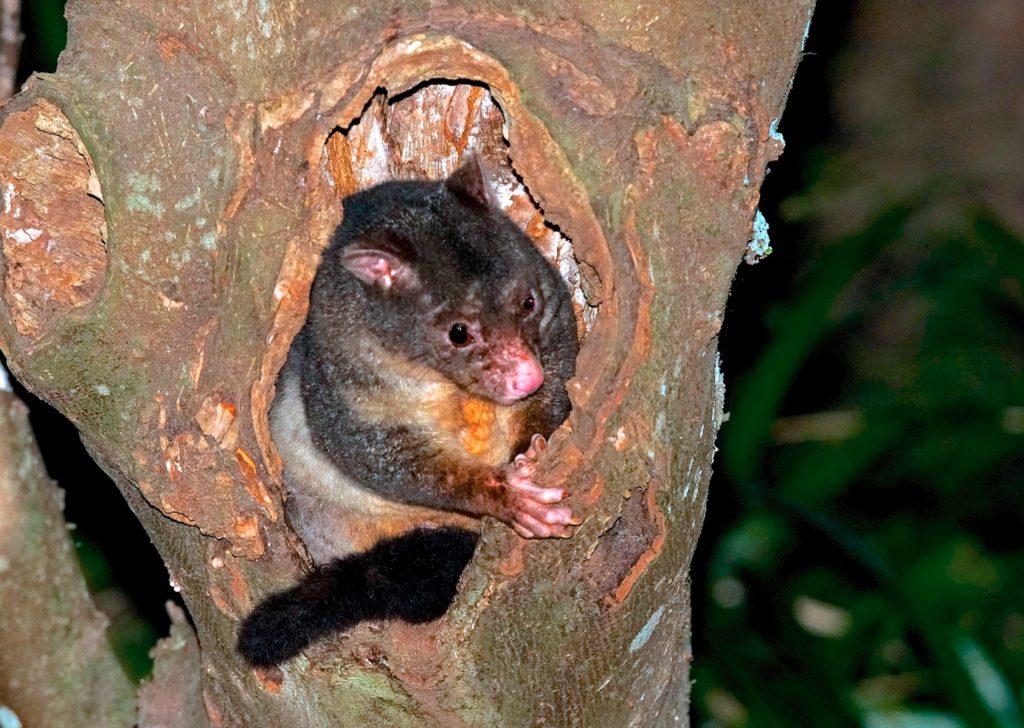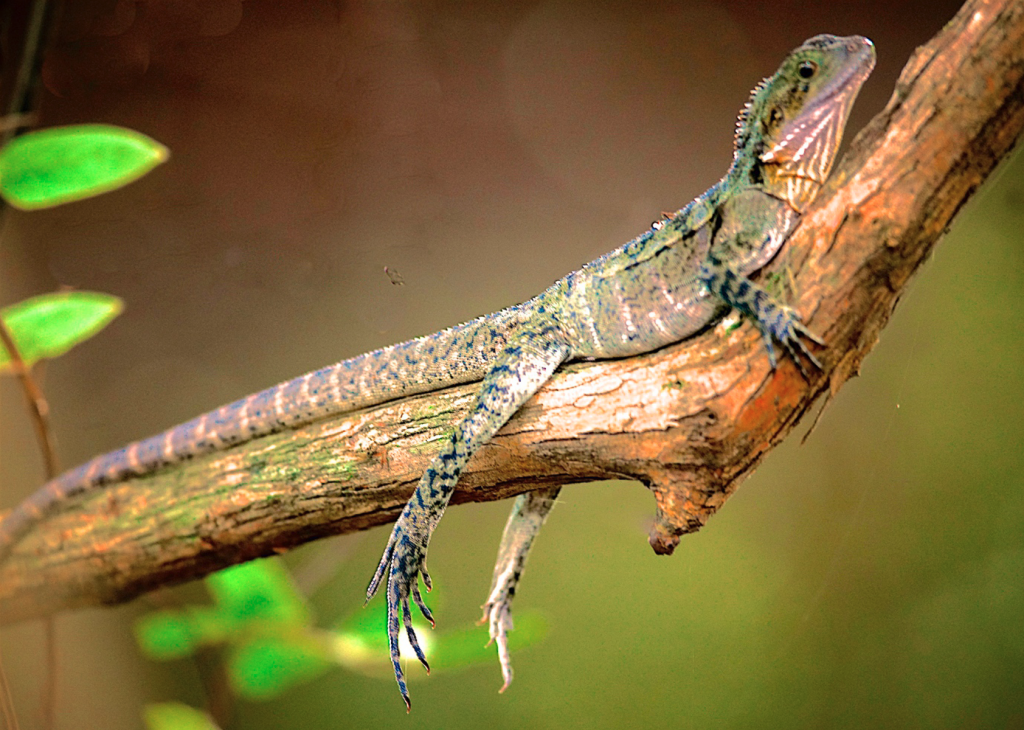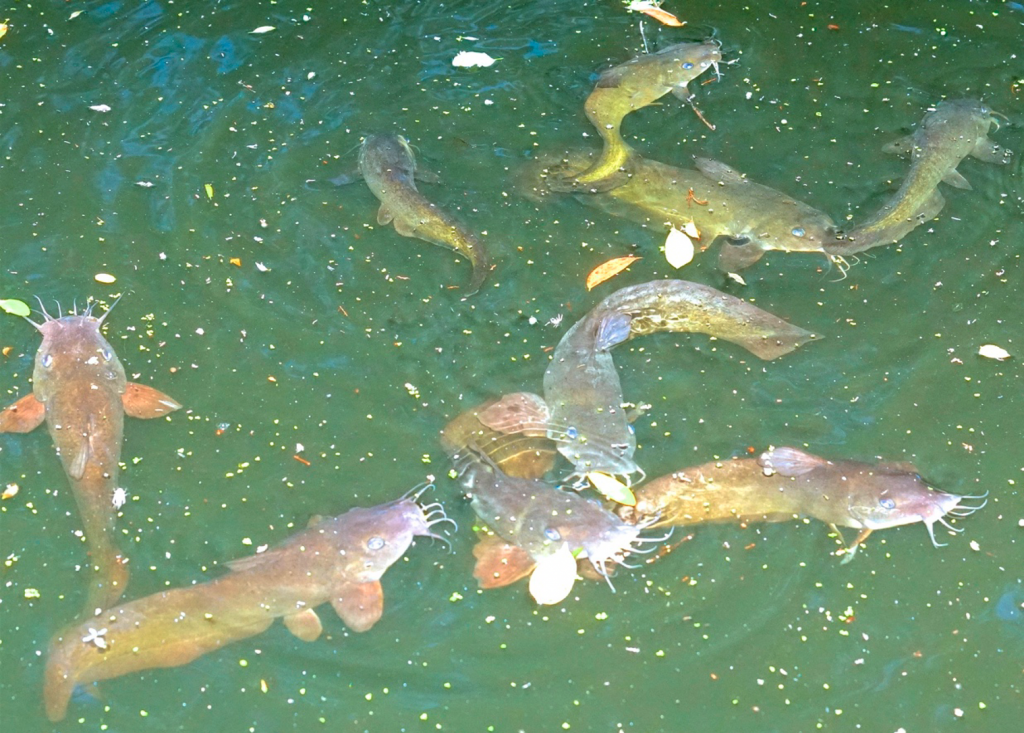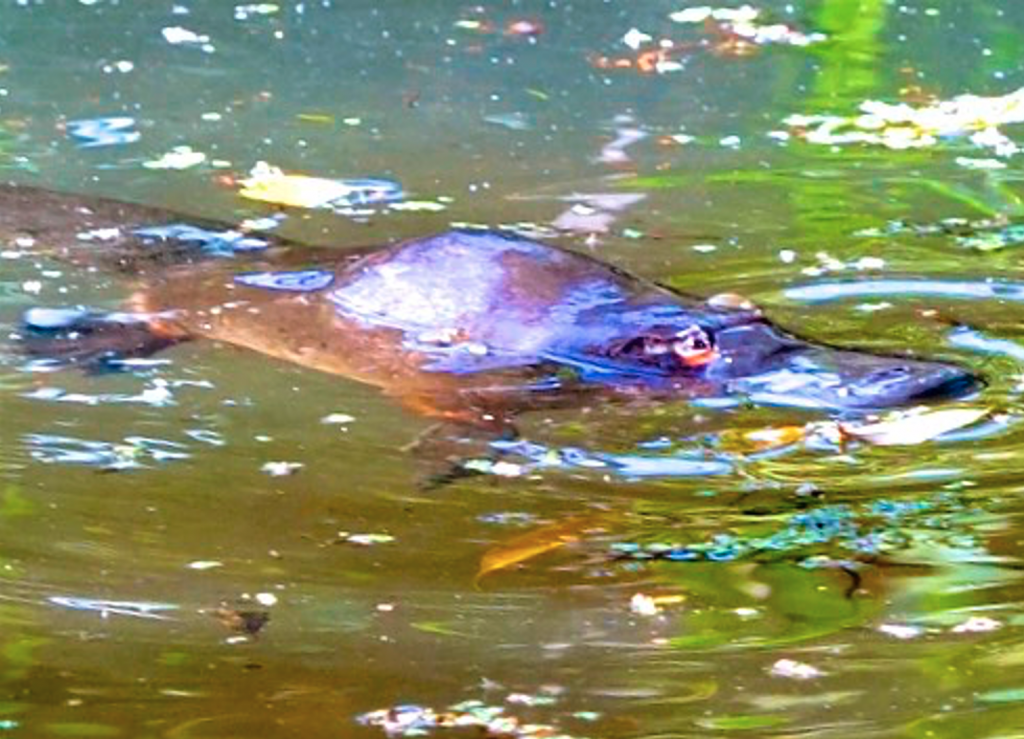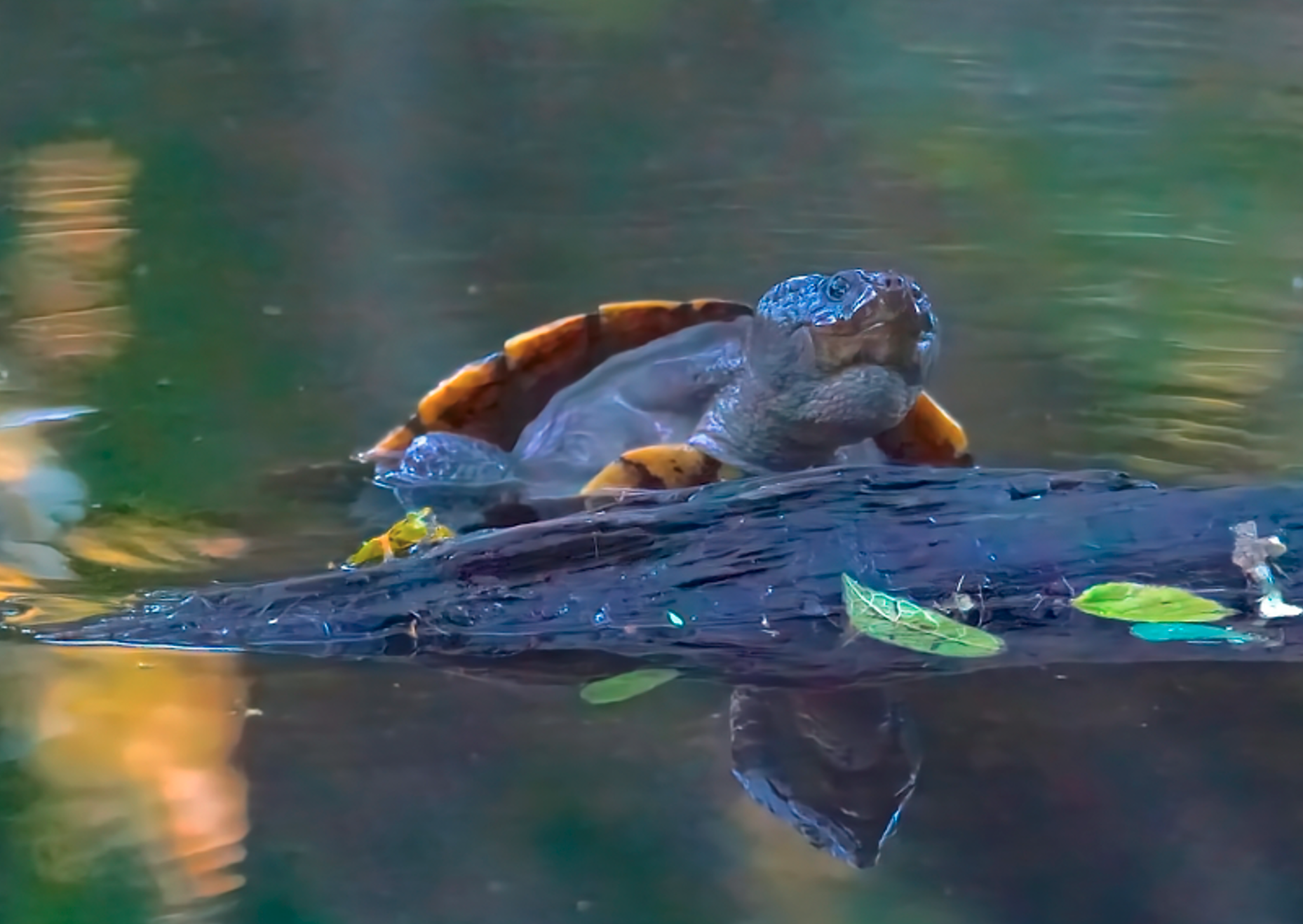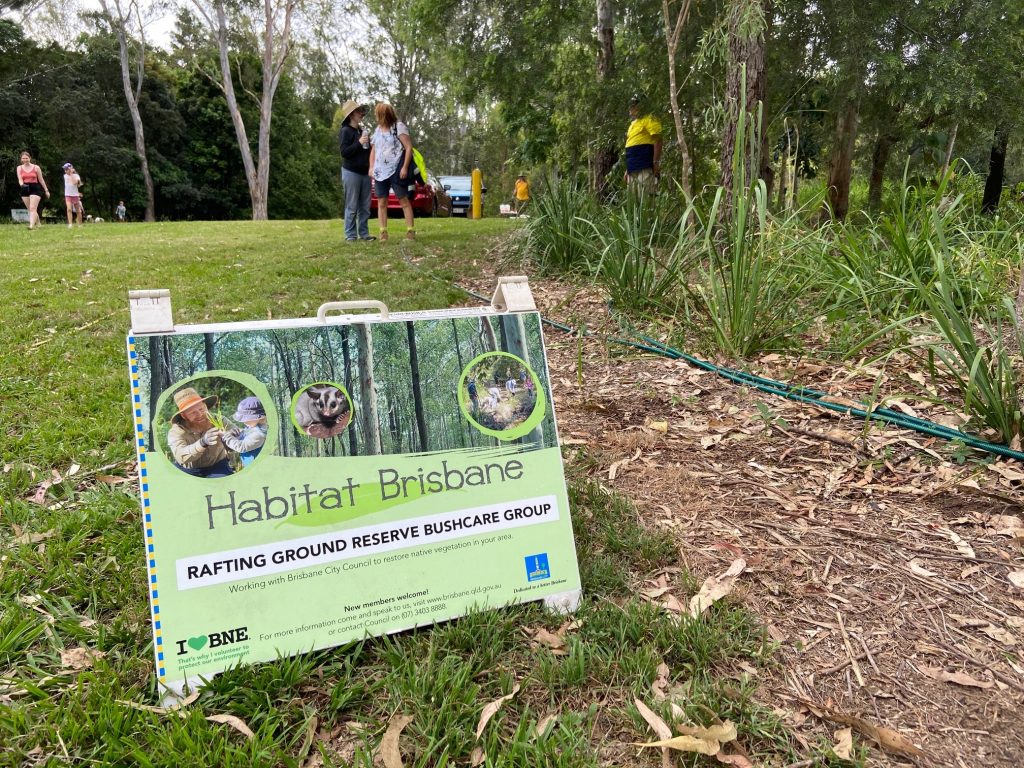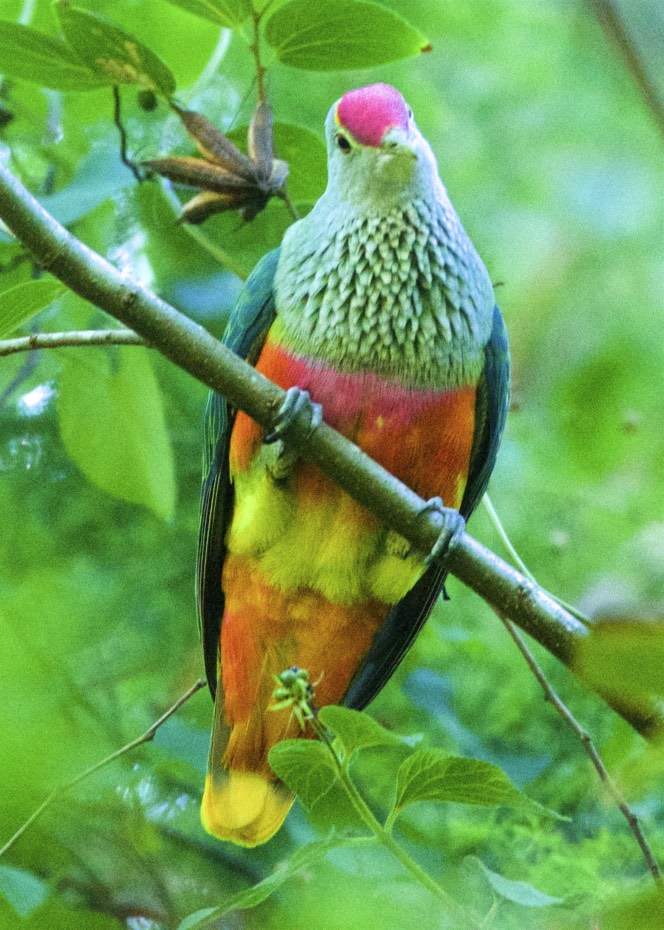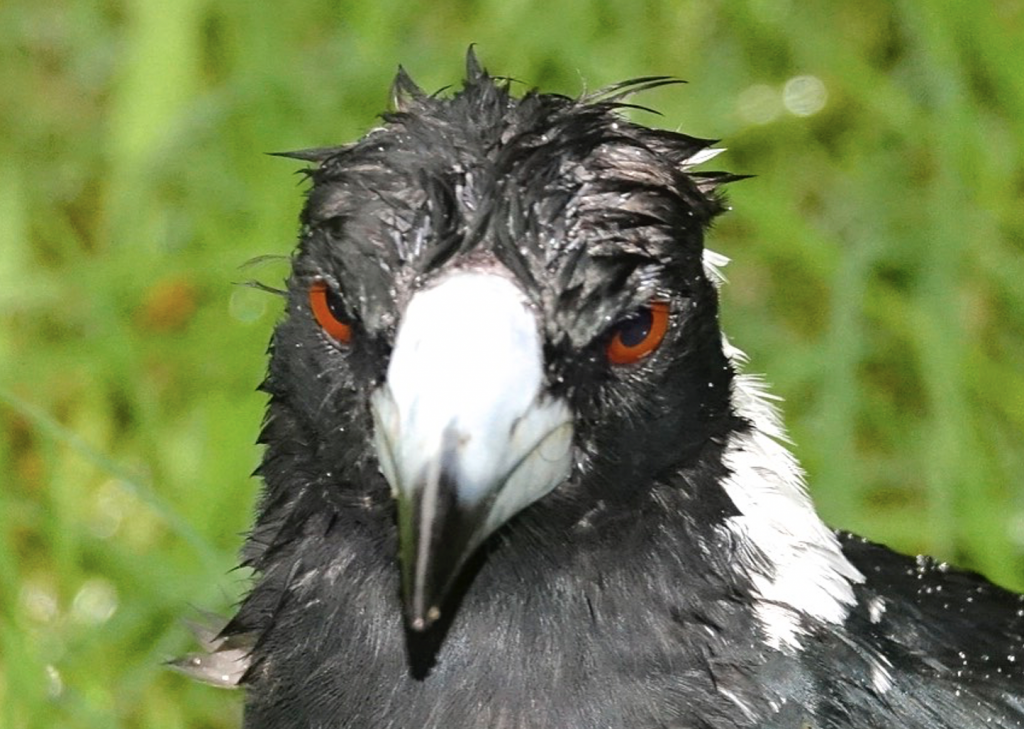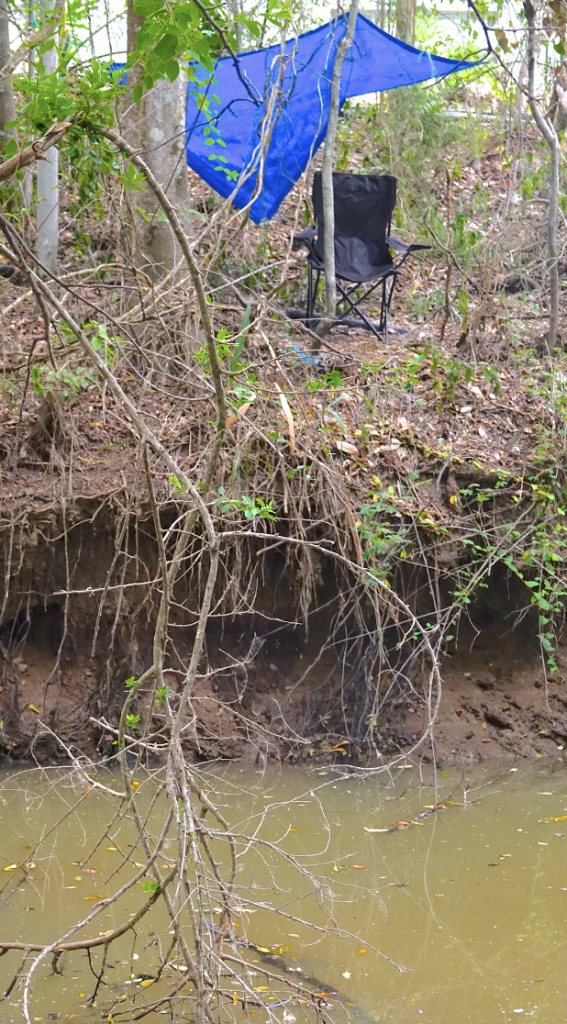News
Creek Health Monitoring Project June Events
Volunteers needed to take part in a macro-invertebrate, fish identification and water health survey.
Citizen Science Events –
- Monday 6th June – Waterway Health Survey
- Saturday 11th June – Waterway health survey
- Sunday 19th June – Waterway health survey
We are looking at waterway health and you can help! Volunteers needed to take part in a water bug, fish identification and water health survey. The day is suitable for budding beginners through to macro-invertebrate maestros with team leaders available to guide you. By participating in this project you will be assisting in collecting valuable data on what are regarded some of the most pristine creek lines close to Brisbane. Come test the waters of citizen science. For more info or to register your attendance please email [email protected]
Where
Brookfield (meeting point will be advised for each survey day).
Please check emails leading up to event.
When
0900-1200
Who
Anybody with a reasonable level of fitness not afraid to get their shoes wet. Young Citizen Scientists (10+) welcome with an adult.
What to wear & bring
Remember to wear suitable outdoor clothing, enclosed shoes that you don’t mind getting wet, a hat, sunglasses and water bottle. Lunch provided.
More information
Email: Lewis [email protected]
Supporters
The Creek Health Monitoring Project is a Citizen Science project undertaken by Moggill Creek Catchment Group. Proudly supported by the Queensland Government -Queensland Citizen Science Grants and Brisbane City Council.
Wildlife Matters!
Recent Flooding
We all remember well the recent rainfall event. Over the four days 25th – 28th February in Kenmore Hills we recorded 795 mm. Sadly, many residences close to Brisbane’s creeks were seriously flooded. But vegetated areas along creeks were also impacted, effects varying depending on the nature of the vegetation and age. Recent plantings were in many cases flattened and even moderate sized trees were bowled over. Logs and branches carried downstream caused considerable damage to existing trees, as the photo shows, in which a large log has impacted a mature fig tree on the bank of Moggill Creek. Owing to potential danger associated with the flooding, permission for bushcarers to rescue damaged trees on Council land was delayed. Different species differ in relation to recovery, with the creek sandpaper fig being especially good at recovering from being bowled over, hanging on by a few roots and sprouting from along its trunk, whilst the river she-oaks are just bowled over and may not recover.
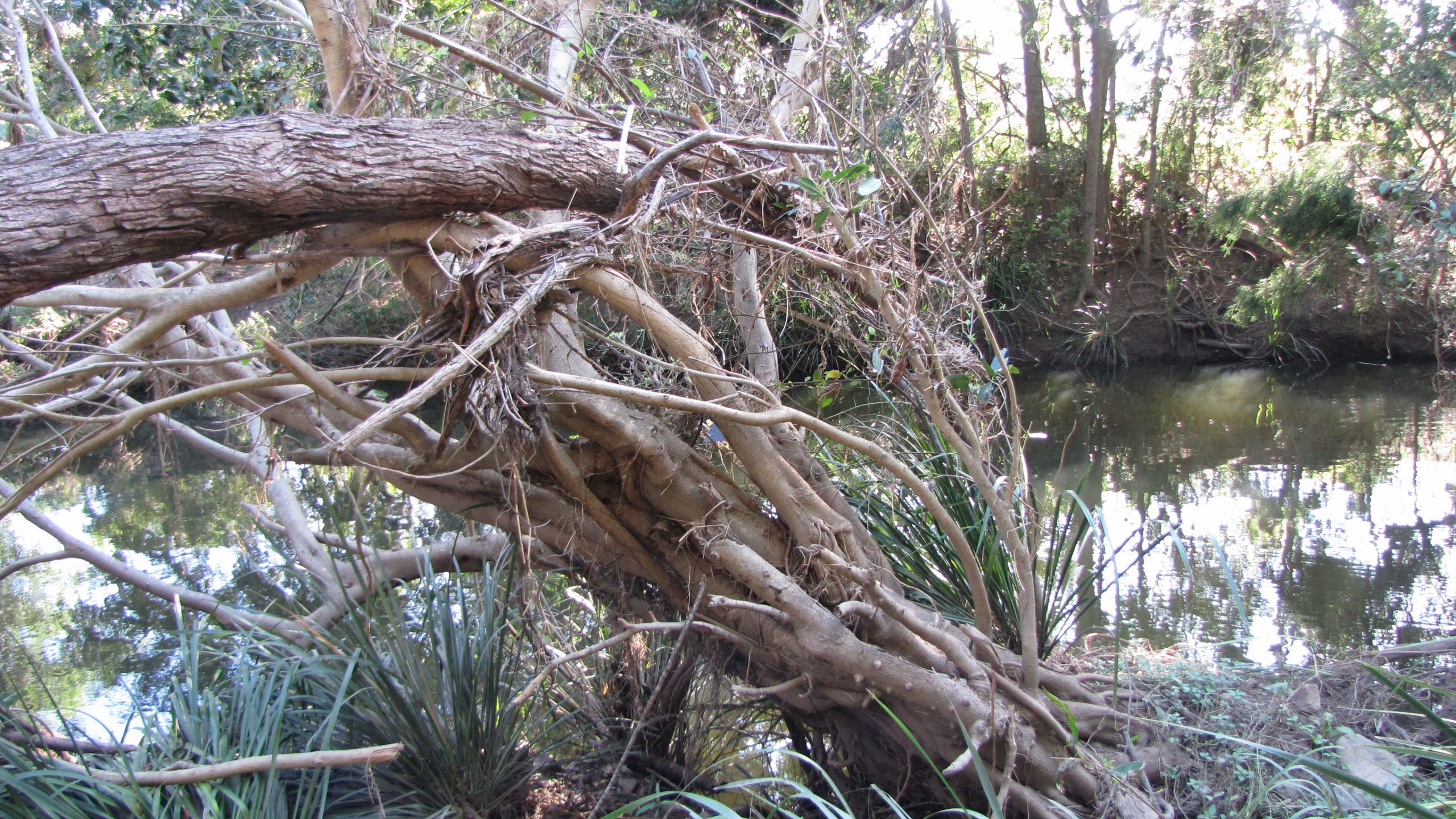 Fig tree impacted by floating log
Fig tree impacted by floating log
The other adverse effect of creek flooding is debris and plant material being washed downstream. Many of the understorey weed species take root again after having been moved and the climber Madeira vine will spread by its tubers being washed downstream too. Where creek margins had been cleared of all vegetation, significant erosion would have occurred and where weed species are the only ones present on flood-prone land, it is desirable to remove them progressively, replacing with natives, to avoid significant erosion. Lomandra species especially are superb at holding the soil in place and emerge unaffected following days underwater, as shown here.
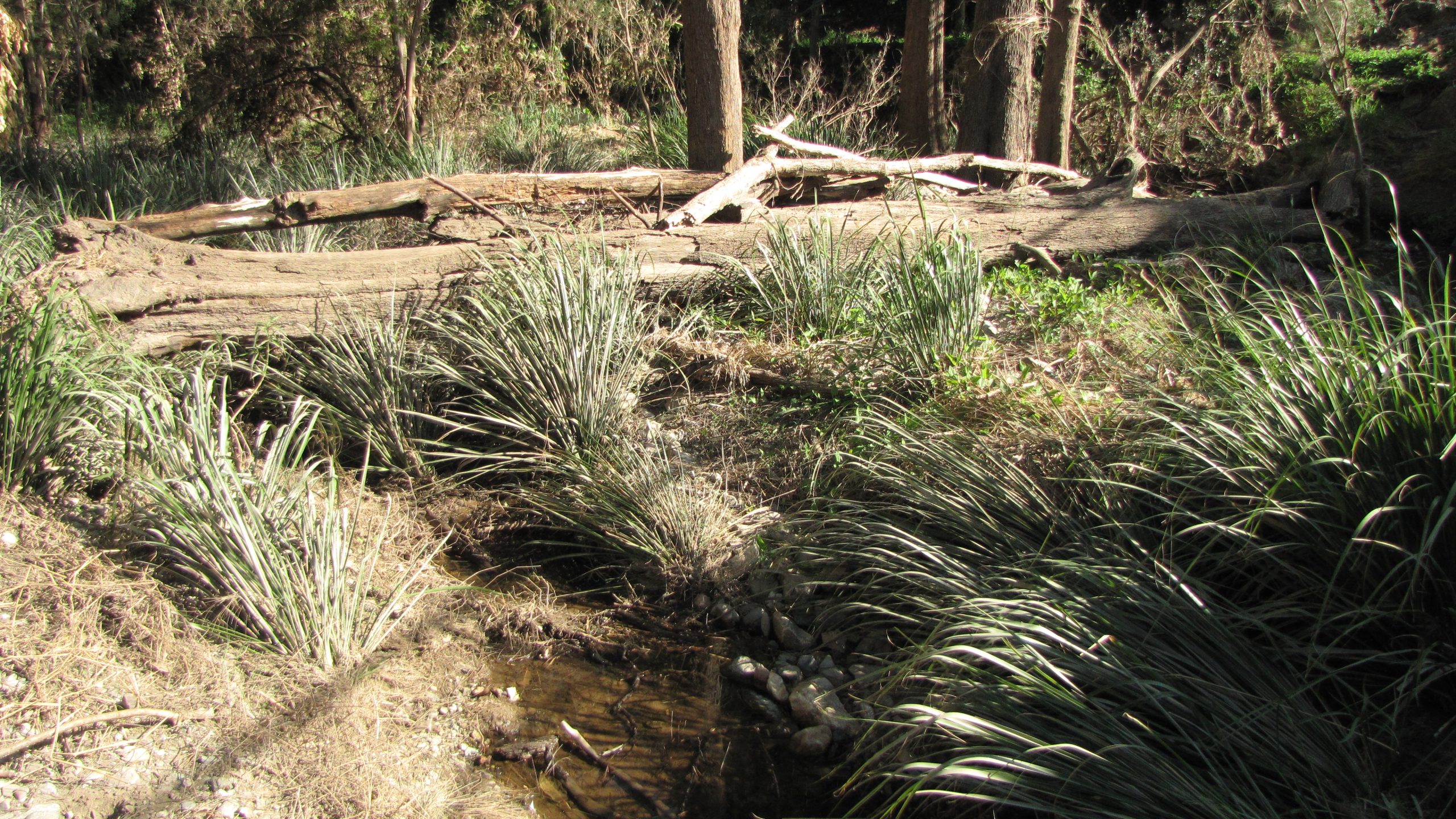 Lomandras flourish and control erosion
Lomandras flourish and control erosion
Away from flooded areas the rain has largely been welcome, although some landslips have occurred. Plants – both native and exotic – have benefitted from the improved moisture. Where exotics such as signal grass have been removed native grasses have flourished and produced seed following the rain. Varying depending on species, tree species will have benefitted too, through moisture penetrating to the subsoil.
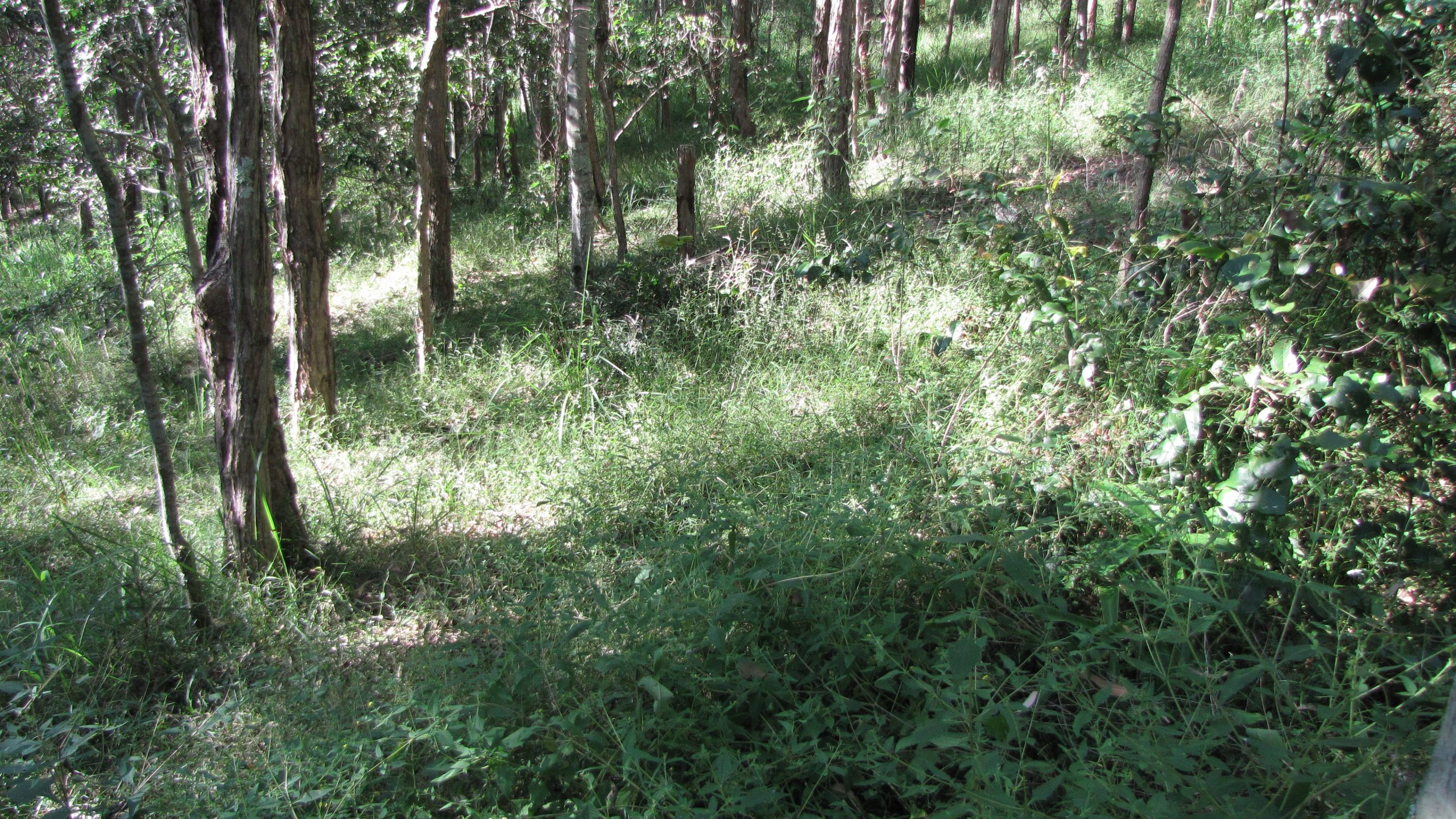 Woodland with native grass understorey benefits from increased moisture
Woodland with native grass understorey benefits from increased moisture
Words and Photos by Bryan Hacker
Published in

Moggill Magic
Moggill Magic this issue features the Moggill Creek Catchment Group Newsletter which has been published quarterly since the Group was started 22 years ago. The Newsletter has been the main communication vehicle for the MCCG and is widely read by local members and even as far wide as Sydney and Melbourne.
It has covered the efforts of the MCCG Bushcare Groups, the Annual Photo Competition, The Kids Day at the Cottage, Dale’s Cottage Talks and the recent popular evening presentations at the Showgrounds Hall. It has also included informative local articles on native plants, weed control and native fauna. We are fortunate to have several experts living within the catchment who have contributed authoritative articles on a wide range of subjects from birds, butterflies, frogs, landscaping, platypus and creek health.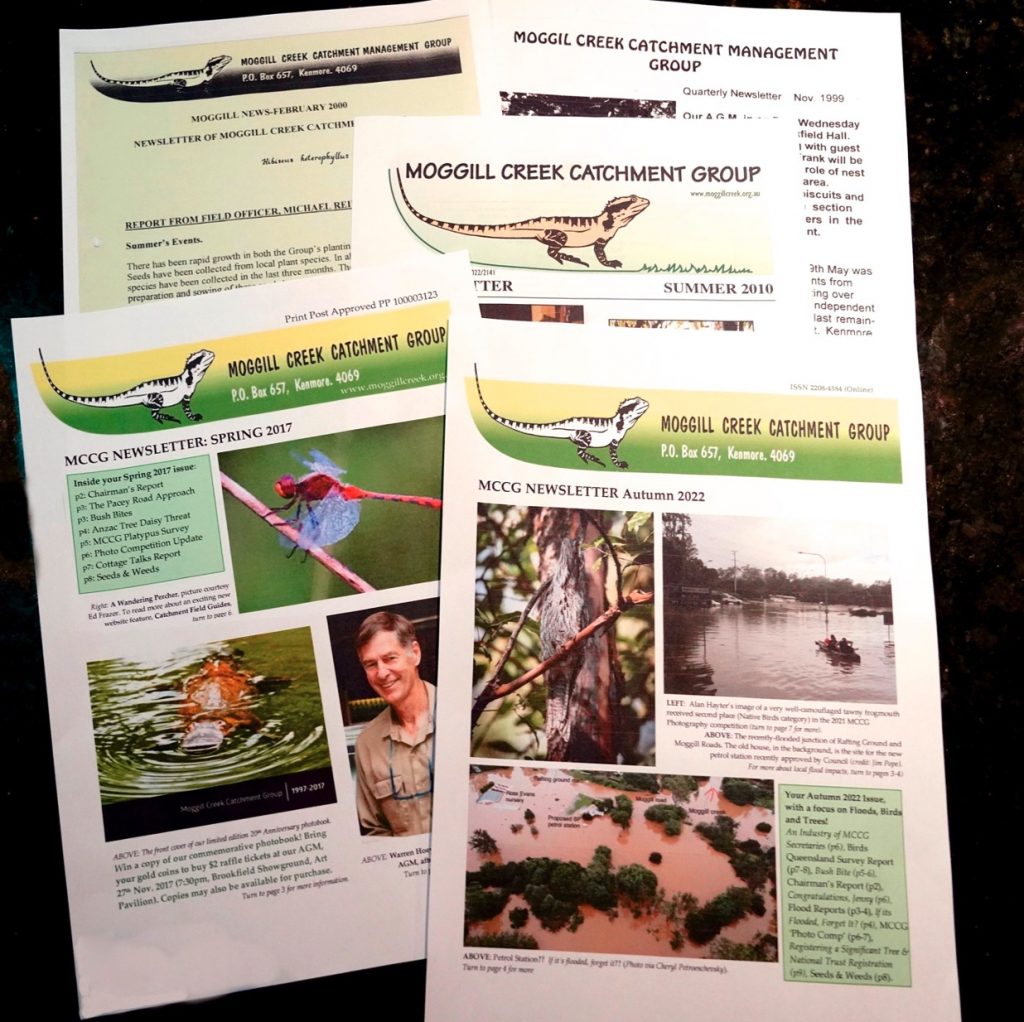
The MCCG Newsletters from the first issue on November 1999 to 2012
None of this would have been possible without the dedicated work of our two Editors, the late Graeme Wilson and our present editor Cathi Lawrence.
This issue is Cathi’s 22nd Newsletter and she has brought a professional expertise to the Newsletter that has lifted the publication to an exceptionally high standard. Cathi has not only produced a highly attractive publication she has cleverly cajoled the contributors of articles to supply a newsletter with a regular balance of articles on people and activities in the catchment with topical and informative articles on the fauna and flora of the area.
The work that goes into producing each issue is enormous and Cathi’s highly disciplined approach results in the timely production of the newsletter each quarter.
A recent letter to the MCCG Secretary put it well:
Dear Zoe
Thank you for the latest Newsletter, what a delightful and informative issue. I was really interested in the information on the likelihood of our native wild life survival during the flood. It would seem that Nature is able to cope so much better than the humans.
The article was well illustrated and most informative. As someone who finds using a computer difficult, I really appreciate the Newsletters and can only admire those responsible in producing such an excellent product.
Thank You
Peter Strickland.
The MCCG Newsletter is truly Moggill Magic and a large contributor to the success of the Moggill Creek Catchment Group.
Words and photo by Ed Frazer
Just another tree?
Across Gold Creek from my hide, where I have been monitoring a breeding Platypus in recent years, is a Sandpaper Fig. Its notable feature is that it is old, but apart from that it is just another tree arching over one of the two large ponds of the creek.
I have taken an interest in this tree because there are long periods of waiting between sightings of the platypus, but there are many similar trees overhanging the creek.
How it got to be growing just in this position could probably be because one of the figs from further upstream was washed down the creek and was deposited in a recess in this section of the creek many years ago.
I have no idea how old the tree is, but it has clearly seen better days as it has lost many branches and shows several signs of old age including severe termite attack. It would certainly have been around in the first half of the 20th century when this section of Gold Creek was the local swimming hole. It was probably around before the land was cleared and used as a dairy farm by the Dart brothers. I can imagine it existed when members of the Turrbal or Jagera aboriginal groups populated the area. Perhaps the aboriginal children snacked on its fruits before lollies were available from the Brookfield store.
Since the cattle went, Chinese Elms have invaded the cleared areas and the swimming hole is no longer used, but the creek banks have a good cover of Sandpaper Figs and Creek Lily Pillies and other natives, so this section of Gold Creek is in good condition and supports a wide range of wildlife.
The Sandpaper Fig has many decayed limbs, and one hole is the resting place of an elderly Northern Mountain Possum. He camps here during the day when he is visiting this part of his territory. The Sandpaper Fig is interconnected with other trees along the creek by several vines. When the possum wakes up in the evening, he climbs upwards and takes off on an aerial highway that covers much of the creek.
He is joined by many other inhabitants who also use this network. Young water dragons sleep along the thinner branches during the night where they are safe from cats and other predators.
If the Water Dragons sense danger, they just plop into the water and swim to safety.
Many birds frequent the fig’s canopy. Lewin’s Honeyeaters are always present – not for nectar, but insects which form much of their diet. Whipbirds are also common, and the fig produces fruit for a range of fruit eaters including Pale-headed Rosellas, Figbirds, Satin Bowerbirds and Rose-crowned Fruit-doves. Brush Turkeys and Noisy Pittas feed on the figs that fall on the banks of the creek. Striated Pardalotes use the fig as a staging post as they excavate their many holes in the bank of the creek where they raise their young. One parent will wait impatiently in the tree with an insect in its beak while calling incessantly until the other parent leaves the hole and it is their turn to feed the hungry young.
Most of the figs fall into the water and there is always a team of Eel-tailed Catfish waiting below.
As well as fruit the Sandpaper Fig drops a considerable number of leaves throughout the year. These rot down in the water and start a food chain involving bacteria and fungi, which are eaten by worms and aquatic insects such as dragonfly, mayfly and midge larvae, which are then eaten by fish and platypus.
The creek is usually ankle deep in mulm derived from the leaves and fruit and the platypus’s bill with its electrified sensors is ideally adapted to sifting out the insects and worms contained in the debris.
When the creek floods the mulm is washed away and a new cycle develops where the whole process speeds up with the input of minerals and light. Floods undercut the banks developing suitable dens for the platypus and water rats. Here too, roots of the Sandpaper fig stabilise the bank. The underground extent of the fig is just as large as the aboveground branches and trunk and the fig produces two distinct types of roots. The structural roots support the trunk and branches and take up water. The fine roots collect the nutrients to feed the growth.
The trees along the creek are essential for the health of the creek and support an amazing amount of wildlife. Clearing to the edge of the creek destroys this habitat and leads to a breakdown of the ecology of our waterways. The work of the MCCG environmental restoration groups in revegetating our waterways is vital to maintaining Moggill and Gold Creeks in a condition that is as close to pristine as any waterway in Brisbane.
FOOTNOTE
The Sandpaper Fig was snapped off by the recent flood and washed downstream to the bridge at the junction of Adavale St. and Savages Rd. The Mountain Possum hole survived but it is very exposed, and it is doubtful it will be used again. A few young branches remain but the main trunk was severed about 2 metres above the ground. The entire root system survived and held the bank well so the old tree will rise again, but it will be many years before it plays its part in supporting the animals with food and the aerial highway above the creek. In the meantime, other young trees will take advantage of the extra light and take the old fig’s place in the canopy above Gold Creek.
Words and photos by Ed Frazer
Know Your Wildlife Quiz
How well do you know the local wildlife? You are invited to meet the Wildlife Identification Challenge!
CAN you identify these native turtles using the Catchment Field Guides? Which of them can emit an offensive odour when handled?
Answers
- Brisbane Short-necked Turtle (Emydura signata)
- Eastern Long-necked Turtle (Chelodina longicollis)
- Saw-shell Turtle (Myuchelys latisternum)
The Eastern Long-necked Turtle can emit an offensive odour when handled.
Published in

Bushcare working bees have recommenced post flooding.
Post flood site assessments have now been done by Habitat Brisbane and bushcare working bees have recommenced around the catchment.
Why not join in the Rafting Ground Reserve Bushcare site (next to Pullenvale/Moggill Rd traffic lights) on Monday 2nd May 9-11am. Along with some light weeding, Alex will be sharing information on indigenous history of our bushcare sites.
Evening Talk with Monica Richter (WWF) April 20th
MCCG is very proud to host Monica Richter for an evening talk on Wednesday April 20th at 7pm.
Monica Richter, Senior Manager, Low Carbon Futures, Worldwide Fund for Nature (WWF) will present economic strategies to mitigate climate change. Monica is an economist and social ecologist with extensive experience in environmental sustainability and an interest in the role of business in accelerating the uptake of low and zero carbon solutions.
Please join us for this event at The Brookfield Hall, refreshments provided. Doors open 6.30pm.
Wildlife Matters – Migration Time
 In our modern world we take little notice of the twice-yearly migrations of huge numbers of our native birds. Knowledge of these seasonal movements was a major part of the Aborigines’ culture. Bird migrations marked the changing of the seasons and were important to their survival. Even our farmers in the past related the comings and goings of the birds to their planting of crops. Our location in Brisbane is right in the centre of four main migrations, north/south, south/north, east/west and west/east.
In our modern world we take little notice of the twice-yearly migrations of huge numbers of our native birds. Knowledge of these seasonal movements was a major part of the Aborigines’ culture. Bird migrations marked the changing of the seasons and were important to their survival. Even our farmers in the past related the comings and goings of the birds to their planting of crops. Our location in Brisbane is right in the centre of four main migrations, north/south, south/north, east/west and west/east.
The next few weeks are the prime time for the Autumn migration when one group of birds is arriving and another group that came in spring is leaving. Shortly the beautiful Rose-crowned Fruit-doves will leave for Northern Queensland and Papua-New Guinea. They will guide their chicks, only a few months old, to the northern grounds to avoid our winter. They will be accompanied by the equally beautiful Sacred Kingfishers and our migrating super star the Latham’s Snipe which goes all the way to Japan.
At the same time millions of Yellow-faced Honeyeaters will arrive from Victoria to feast on Eucalyptus nectar. They fly mainly at night in such huge flocks that they show on the BOM radar. Another southerner that will arrive in a few days will be the Grey Fantail. Not as spectacular, but very friendly and just as common in the suburbs as in the bush where they are easily seen competing for insects with the Willie Wagtails. One spectacular species arriving soon is the Noisy Pitta. A ground foraging bird that breeds on the Dividing Range and migrates to the coast, where unfortunately it is vulnerable to our cats at night. Small flocks of Pacific Bazas, our Crested Hawk, will also arrive to feed on Stick Insects high up in the tops of Eucalypts.
Many of the Cuckoos species will soon leave to go north for warmer conditions. Some go to North Queensland and some to PNG and the Coral Sea Islands. How a young Channel-billed Cuckoo (Flying Hockeystick) knows where to go is a mystery as cuckoos are raised by other species. They are parasitic birds laying their eggs in other birds’ nests. As well as other large cuckoos such as the Cooee Bird (Koel) there are several smaller cuckoos that leave for the north at this time, but some individuals of a few species such as the Shining Bronze-cuckoo choose to stay for the winter and we don’t know why.
There is so much more to understand about these migrations. We know little about how they navigate – often to an exact location every year. Many fly during the night probably using the stars or some other astronomical system. How do they know the exact time to leave each year? Why do some migrate while others stay? Some fly non-stop while others have feeding stop-off places where they replenish their strength. Migration is an amazing phenomenon and we are right in one of the best places in Australia to see it unfolding.
Ed Frazer
Published in

Bush Bites – Wildlife in the Wet
Surviving the floods has been a test of our resilience in recent times, but how do the local wildlife manage the storms and the flooded creeks?
The answer is surprisingly well. Many species have very attuned senses and they are in many cases better forecasters than Bureau of Meteorology when it comes to detecting imminent storms. Most of our birds can easily detect drops in barometric pressure, wind changes, temperature drops, lightning and thunder miles away and either fly off to safer locations or take shelter in dense foliage or in nooks and crannies of tree trunks. Small birds are experts at positioning themselves close to the trunks on the leeward faces of the trees.
The biggest danger for birds is during nesting when eggs or young can get flooded. It pays to check out your area after a big storm. Several years ago I was out inspecting the damage from a particularly heavy rain period and I heard some tiny chirps at the base of an Iron bark tree and found a pair of small chicks with only pin feathers. I knew they were parrots but after feeding them for several days I was amazed to find they were Major Mitchell Cockatoos. I was aware of the parents who regularly visited us after they were expelled from a flock of 6 that lived up near the Gold Creek dam. After the chicks were fully grown they flew up into a Grey Ironbark and one re-joined the parents and the other cried for three days until I climbed about 12 metres up the tree to retrieve it. After another storm I found a Black Bittern, a seldom seen bird in Brisbane, resting after sheltering from a particularly bad storm.
Many of the larger birds just sit out in the rain and take advantage of the feast of worms flooded out to the surface. Generally, the birds manage the storms quite well.
A bedraggled but very satisfied Australian Magpie after feasting on worms brought to the surface by the flooding rain.
With the huge volumes of water flowing down Gold and Moggill Creeks during the recent flooding you might wonder if all the fish were washed down the Brisbane River into Moreton Bay. Fish are also adept at handling the conditions. The main defence of the Eel-tailed Catfish is to find deep spots in the creeks where the water flow is less strong. Other species move to the edges of the water where they find slower water behind obstructions such as clumps of refuse, large tree bases and side channels. It is well-known that the small mosquito fish, Gambusia, swims up the edges of the flow in floods and this is how they successfully populate farm dams where they were never intentionally introduced. Some natives such as Firetailed Gudgeons also use this method. Flooding can be a bountiful time for fish as fast water can dislodge aquatic insect larvae such as Dragonflies and Mayflies making them easy food for the waiting fish.
Fish are also highly streamlined and coated with mucus which reduces the friction and makes them highly capable of swimming against strong currents.
Frogs are very well adapted to flood periods, which actually stimulate their breeding as their calling during the recent rains will testify. The constant wet weather makes it easy for them to travel and some species make use of flooding conditions. The Great Barred and the Great Brown Brood-frogs lay eggs well away from creeks under stones or in clumps of grass and rely on flood water to wash their eggs into the waterways. Other species such as the Ornate Treefrogs and Ornate Burrowing Frogs lay their eggs in temporary ponds where there are fewer predators. These species develop very rapidly with the Ornate Treefrog taking only three weeks in the tadpole stage as they feed on the algae and micro-organisms that develop rapidly in the ephemeral ponds.
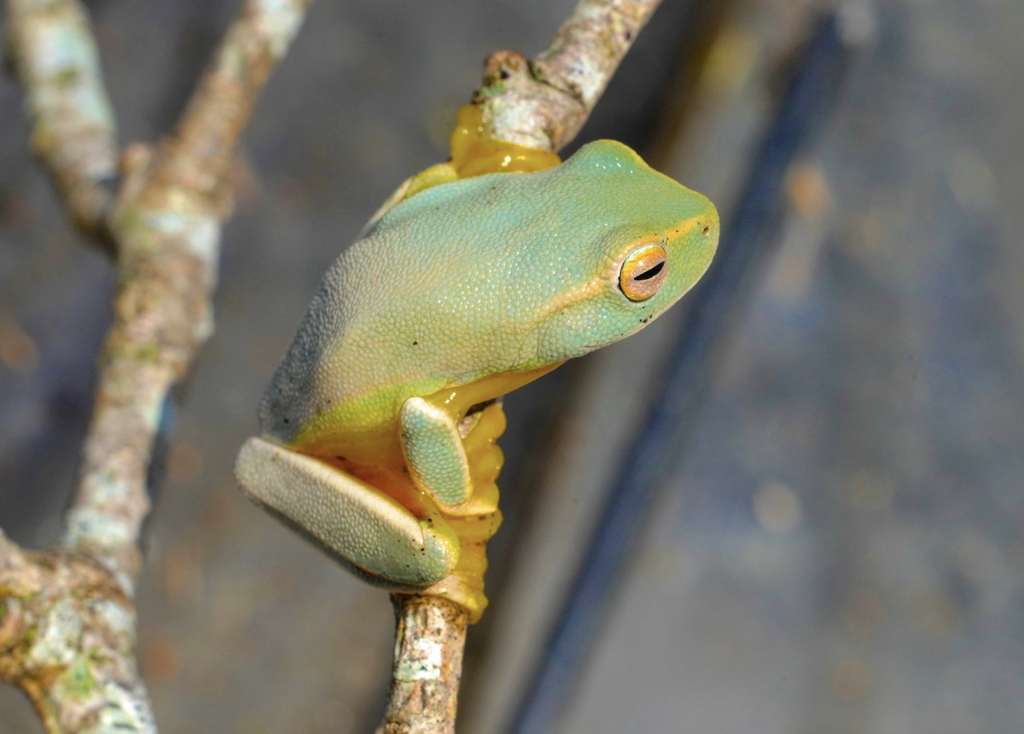 The Ornate Treefrog lays eggs in temporary water after heavy rain. They go through metamorphosis in 6 to 8 weeks.
The Ornate Treefrog lays eggs in temporary water after heavy rain. They go through metamorphosis in 6 to 8 weeks.
For our two aquatic mammals, platypus and water rats, big floods can cause some problems. Both are highly intelligent animals and they also have some heightened senses and quickly adapt to changing conditions.
The Platypus have two types of dens. Breeding Den entrances usually are at normal water level and rise upwards and go back a metre or two. Fortunately the young were out by about the end on November so there would have been no losses of pugs during the recent flooding.
The Platypus have several other dens where they hole up during the daytime during the rest of the year. Along our part of Gold Creek there are lots of places where the banks are undercut from earlier floods and many go back a considerable distance and are well above normal water level. The Platypus use multiple dens along their range depending where they are feeding. During the recent flood most dens would have been underwater and the Platypus would have to move out. They are extremely strong swimmers and would have skirted around the edges of the flood and probably made temporary dens in the flotsam pushed up from the flood.
An undercut bank in Gold Creek which a Platypus has been using for several years. It goes back at least 1.5metres. The Platypus’ senses are so acute that it can detect movement at the lookout above.
The Water Rats are not as committed to needing an aquatic environment as the Platypus. They regularly raid our nursery buildings well away from the creek and steal goldfish and ornamental snails. They are very clever animals and would have had no difficulty in finding cover for their daytime sleeping quarters while the flood was raging. They would not have any problem keeping warm as they have one of the most dense waterproof furs of any animal.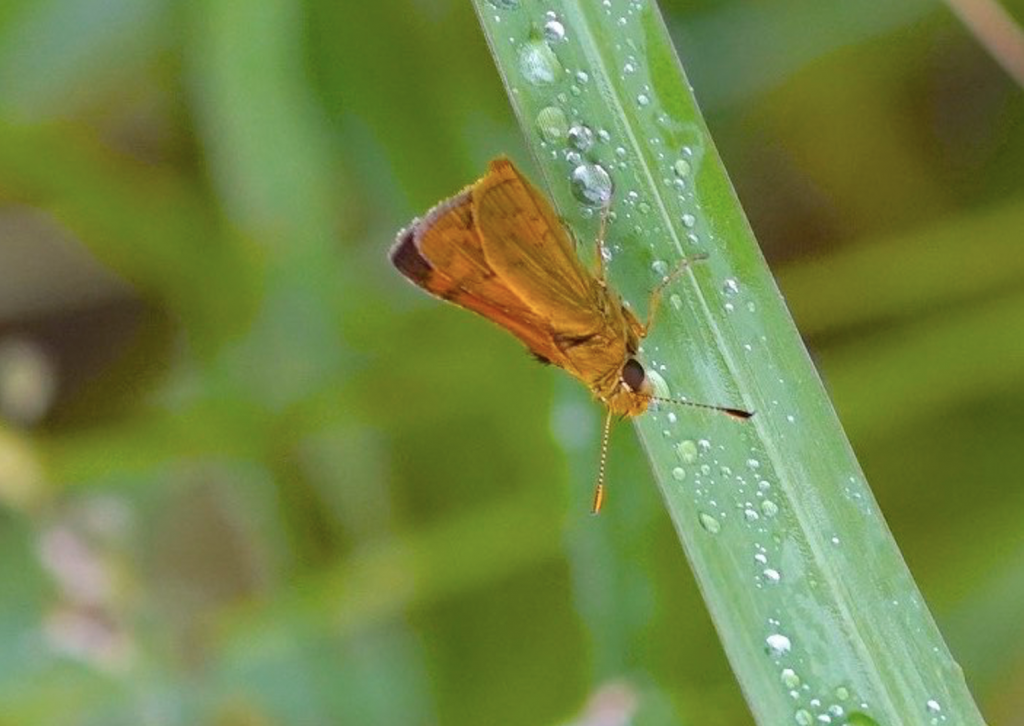
A Grass Skipper butterfly sheltering from the rain
Butterflies are rather delicate creatures and small enough that a raindrop in comparison to their size would be like a 10-litre bucket of water hitting us. They have a number of defences, but foremost is simply perching on the undersides of a good strong leaf. Some shelter in nooks and crannies of trees and the common Evening Browns shelter under clumps of grass. Ladybirds also shelter on the undersides of leaves and some species congregate in large numbers under loose bark of Eucalyptus trees.
After the Flood.
Mostly our wildlife survive these periods quite well if they don’t coincide with their breeding season. But after the flooding there can be a period of where feed can be in short supply. Nectar and insect eating species can have problems, but unless it is just before winter it usually doesn’t take long before things get back to normal.
For seed eaters there can be a feast on the ground.
Fish in the creeks may have a shortage as the insect larvae live in the debris and mulm that will have been washed out. However, in a few weeks the build-up of mosquito and midge larvae will result in plenty. Without these periodical flooding events the creeks get overgrown and the water quality goes down so the cleanout and inflow of water from the land loaded with nutrients results in a bloom that starts a flush that benefits the environment and the animals living in our creeks. This recent event fortunately was during the warmer months so the recovery will be rapid.
Photos and words by Ed Frazer.




